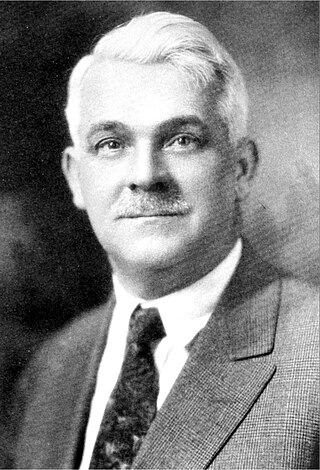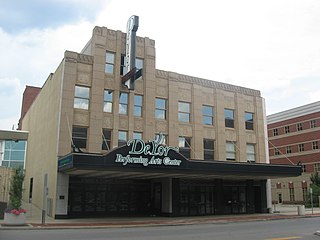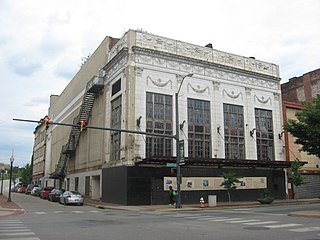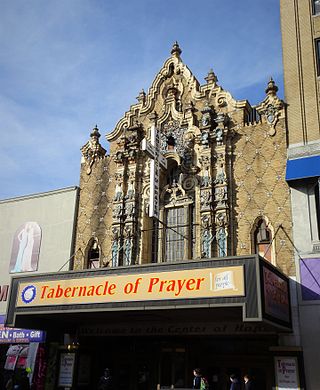
Trotwood is a city in Montgomery County, Ohio, United States. The population was 23,070 at the 2020 census. A suburb of Dayton, it is part of the Dayton metropolitan area. The city is served by the Trotwood-Madison City School District.

Salem Mall was a shopping mall in Trotwood, Ohio, a suburb of Dayton, Ohio, United States. It was built in 1966 by The Rouse Company and originally featured Rike's and Sears as its main anchor stores. Expansion in 1981 added a new wing of stores and JCPenney, while further renovations in that same decade included a food court. Rike's was later dual-branded as Shillito-Rike's and then renamed to Lazarus The mall began to lose stores throughout the 1990s, including both Lazarus and JCPenney, the former of which was torn down for The Home Depot. After an extended period of decline, the mall closed in 2005 and was demolished in 2006. Sears, which was excluded from the demolition, remained operational until it closed in 2013. In 2022, it was announced that a large portion of the mall would become the new site of The Funk Music Hall of Fame and Exhibition Center.

Thomas White Lamb was a Scottish-born, American architect. He was one of the foremost designers of theaters and cinemas of the 20th century.

The Kings Theatre is a theater and live performance venue at 1027 Flatbush Avenue in the Flatbush neighborhood of Brooklyn in New York City, United States. Designed by Rapp and Rapp as a movie palace, it opened on September 7, 1929, as one of five Loew's Wonder Theatres in the New York City area. The theater's interior decor was supervised by Rapp and Rapp along with Harold Rambusch. Owned by the New York City Economic Development Corporation, the Kings Theatre has been operated by the Ambassador Theatre Group since 2015. It is listed on the National Register of Historic Places.

Powers Auditorium, in Youngstown, Ohio is one of the largest auditoriums in the Youngstown-Warren area. The facility is the main venue of downtown Youngstown's DeYor Performing Arts Center. The complex also includes the Adler Art Academy, Beecher Flad Pavilion, and Ford Family Recital Hall. Originally built in 1931 as the Warner Theatre, the former movie palace was renovated and reopened as Powers Auditorium in 1969.

A tiki bar is a themed drinking establishment that serves elaborate cocktails, especially rum-based mixed drinks such as the Mai Tai and Zombie cocktails. Tiki bars are aesthetically defined by their tiki culture décor which is based upon a romanticized conception of tropical cultures, most commonly Polynesian. Some bars also incorporate general nautical themes or retro elements from the early atomic age.
Foothills Mall was an indoor regional shopping mall located in Casas Adobes, Arizona, United States, with a Tucson postal address. Foothills Mall had capacity for over 90 stores and outlets, along with 8 restaurants and an AMC Theatres Foothills 15. As of 2023, the mall has been demolished, with plans to convert the existing mall into a mixed-use project.

Heinz Hall is a performing arts center and concert hall located at 600 Penn Avenue in the Cultural District of Pittsburgh, Pennsylvania. Home to the Pittsburgh Symphony Orchestra (PSO) and the Pittsburgh Youth Symphony Orchestra, the 2,676 seat hall presents about 200 performances each year. Originally built in 1927 as Loew's Penn Theatre, the former movie palace was renovated and reopened as Heinz Hall in 1971.

State Route 49 is a state highway in the western part of the U.S. state of Ohio. It begins in Drexel, an area within the city of Trotwood, at US 35 and runs northwesterly to Greenville, and then runs roughly along near the western edge of the state near the Indiana state line to the Michigan state line where it meets with Michigan's M-49.

John Adolph Emil Eberson was an Austrian-American architect best known for the development and promotion of movie palace designs in the atmospheric theatre style. He designed over 500 theatres in his lifetime, earning the nickname "Opera House John". His most notable surviving theatres in the United States include the Tampa Theatre (1926), Palace Theatre Marion (1928), Palace Theatre Louisville (1928), Majestic Theatre (1929), Akron Civic Theatre (1929), the Paramount Theatre (1929), the State Theater 1927, and the Lewis J. Warner Memorial Theater (1932) at Worcester Academy in Worcester, Massachusetts. Remaining international examples in the atmospheric style include both the Capitol Theatre (1928) and State Theatre (1929) in Sydney, Australia, The Forum and Le Grand Rex.

The Liberty/Paramount Theatre was an early movie palace located on West Federal Street and Hazel Avenue in Youngstown, Ohio.

An atmospheric theatre is a type of movie palace design which was popular in the late 1920s. Atmospheric theatres were designed and decorated to evoke the feeling of a particular time and place for patrons, through the use of projectors, architectural elements and ornamentation that evoked a sense of being outdoors. This was intended to make the patron a more active participant in the setting.

The Robert Morton Organ Company was an American producer of theater pipe organs and church organs, located in Van Nuys, California. Robert Morton was the number two volume producer of theatre organs, building approximately half as many organs as the industry leader Wurlitzer. The name Robert Morton was derived not from any person in the company, but rather from the name of company president Harold J. Werner's son, Robert Morton Werner.

The Landmark Theatre, originally known as Loew's State Theater, is a historic theater from the era of movie palaces, located on South Salina Street in Syracuse, New York, United States. Designed by Thomas W. Lamb, it is the city's only surviving example of the opulent theatrical venues of the 1920s. The Landmark is on the National Register of Historic Places.
The Naples Players (TNP) is a community theatre company located in Naples, Florida. The company was founded on January 19, 1953 in the Sugden Community Theatre at 701 5th Avenue South in downtown Naples. It has been named the "Best Live Theatre" in Southwest Florida (including professional theaters) fifteen times by the readers poll of The Naples Daily News.

The Fraternal Order of Moai is a fraternal order and social club founded in 2005 by Matt "Kuku Ahu" Thatcher, Jim "Chisel Slinger" Robinson and Joel "Cowtown Kahuna" Gunn. The Order uses the Moai statues of Rapa Nui as a theme. An initial goal of the group was to preserve the history of and artifacts from the closed Kahiki Supper Club in Columbus, Ohio. Since then it has grown into "a serious group of tiki aficionados" with activity all over the United States. Some describe the group as "a cult within a cult" when discussing the modern Tiki revival.

The Pretzinger name belongs to a family of architects and engineers in Dayton, Ohio. Albert Pretzinger started the family's architectural legacy.

The Valencia Theatre is a former movie palace at 165-11 Jamaica Avenue in Queens, New York City. Built in 1929 as one of five Loew's Wonder Theatres, the theater was donated to The Tabernacle of Prayer for All People in 1977. It was designated an exterior landmark on May 25, 1999, by the New York City Landmarks Preservation Commission.
















